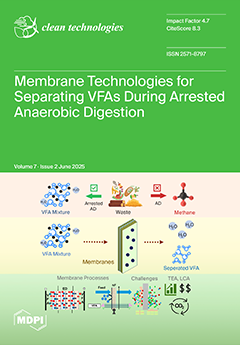This study utilizes a zero-dimensional, constant-pressure, perfectly stirred reactor (PSR) model within the Cantera framework to examine the combustion characteristics of hydrogen, methane, methanol, and propane, both singly and in hydrogen-enriched mixtures. The impact of the equivalence ratio (ϕ = 0.75, 1.0, 1.5),
[...] Read more.
This study utilizes a zero-dimensional, constant-pressure, perfectly stirred reactor (PSR) model within the Cantera framework to examine the combustion characteristics of hydrogen, methane, methanol, and propane, both singly and in hydrogen-enriched mixtures. The impact of the equivalence ratio (ϕ = 0.75, 1.0, 1.5), fuel composition, and residence duration on temperature increase, heat release, ignition delay, and emissions (NO
x and CO
2) is methodically assessed. The simulations are performed under steady-state settings to emulate the ignition and flame propagation processes within pre-chambers and primary combustion zones of internal combustion engines. The results demonstrate that hydrogen significantly improves combustion reactivity, decreasing ignition delay and increasing peak flame temperature, especially at short residence times. The incorporation of hydrogen into hydrocarbon fuels, such as methane and methanol, enhances ignition speed, improves thermal efficiency, and stabilizes lean combustion. Nevertheless, elevated hydrogen concentrations result in increased NO
x emissions, particularly at stoichiometric equivalence ratios, due to higher flame temperatures. The examination of fuel mixtures at varying hydrogen concentrations (10–50% by mole) indicates that thermal performance is optimal under stoichiometric settings and diminishes in both fuel-lean and fuel-rich environments. A thermodynamic model was created utilizing classical combustion theory to validate the heat release estimates based on Cantera. The model computes the heat release per unit volume (MJ/m
3) by utilizing stoichiometric oxygen demand, nitrogen dilution, fuel mole fraction, and higher heating values (HHVs). The thermodynamic estimates—3.61 MJ/m
3 for H
2–CH
3OH, 3.43 MJ/m
3 for H
2–CH
4, and 3.35 MJ/m
3 for H
2–C
3H
8—exhibit strong concordance with the Cantera results (2.82–3.02 MJ), thereby validating the physical consistency of the numerical methodology. This comparison substantiates the Cantera model for the precise simulation of hydrogen-blended combustion, endorsing its use in the design and development of advanced low-emission engines.
Full article





